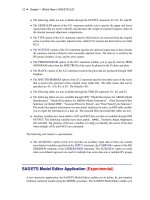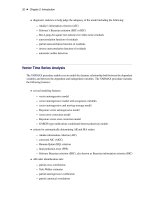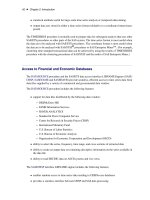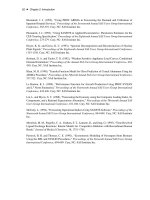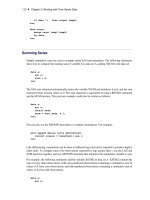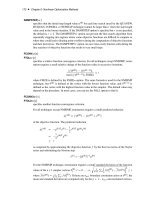SAS/ETS 9.22 User''''s Guide 19 pptx
Bạn đang xem bản rút gọn của tài liệu. Xem và tải ngay bản đầy đủ của tài liệu tại đây (246.61 KB, 10 trang )
172 ✦ Chapter 6: Nonlinear Optimization Methods
DAMPSTEP[=r]
specifies that the initial step length value
˛
.0/
for each line search (used by the QUANEW,
HYQUAN, CONGRA, or NEWRAP technique) cannot be larger than
r
times the step length
value used in the former iteration. If the DAMPSTEP option is specified but
r
is not specified,
the default is
r D 2
. The DAMPSTEP=
r
option can prevent the line-search algorithm from
repeatedly stepping into regions where some objective functions are difficult to compute or
where they could lead to floating point overflows during the computation of objective functions
and their derivatives. The DAMPSTEP=
r
option can save time-costly function calls during the
line searches of objective functions that result in very small steps.
FCONV=rŒn
FTOL=rŒn
specifies a relative function convergence criterion. For all techniques except
NMSIMP
, termi-
nation requires a small relative change of the function value in successive iterations,
jf .Â
.k/
/ f .Â
.k1/
/j
max.jf .Â
.k1/
/j; FSIZE/
Ä r
where FSIZE is defined by the FSIZE= option. The same formula is used for the NMSIMP
technique, but
Â
.k/
is defined as the vertex with the lowest function value, and
Â
.k1/
is
defined as the vertex with the highest function value in the simplex. The default value may
depend on the procedure. In most cases, you can use the PALL option to find it.
FCONV2=rŒn
FTOL2=rŒn
specifies another function convergence criterion.
For all techniques except NMSIMP, termination requires a small predicted reduction
df
.k/
f .Â
.k/
/ f .Â
.k/
C s
.k/
/
of the objective function. The predicted reduction
df
.k/
D g
.k/T
s
.k/
1
2
s
.k/T
H
.k/
s
.k/
D
1
2
s
.k/T
g
.k/
Ä r
is computed by approximating the objective function
f
by the first two terms of the Taylor
series and substituting the Newton step
s
.k/
D ŒH
.k/
1
g
.k/
For the NMSIMP technique, termination requires a small standard deviation of the function
values of the
n C1
simplex vertices
Â
.k/
l
,
l D 0; : : : ; n
,
r
1
nC1
P
l
h
f .Â
.k/
l
/ f .Â
.k/
/
i
2
Ä r
where
f .Â
.k/
/ D
1
nC1
P
l
f .Â
.k/
l
/
. If there are
n
act
boundary constraints active at
Â
.k/
, the
mean and standard deviation are computed only for the n C 1 n
act
unconstrained vertices.
Options ✦ 173
The default value is
r D 1
E
6
for the NMSIMP technique and
r D 0
otherwise. The optional
integer value
n
specifies the number of successive iterations for which the criterion must be
satisfied before the process can terminate.
FSIZE=r
specifies the FSIZE parameter of the relative function and relative gradient termination criteria.
The default value is r D 0. For more details, see the FCONV= and GCONV= options.
GCONV=rŒn
GTOL=rŒn
specifies a relative gradient convergence criterion. For all techniques except CONGRA and
NMSIMP, termination requires that the normalized predicted function reduction is small,
f racg.Â
.k/
/
T
ŒH
.k/
1
g.Â
.k/
/max.jf .Â
.k/
/j; FSIZE/ Ä r
where FSIZE is defined by the FSIZE= option. For the CONGRA technique (where a reliable
Hessian estimate H is not available), the following criterion is used:
k g.Â
.k/
/ k
2
2
k s.Â
.k/
/ k
2
k g.Â
.k/
/ g.Â
.k1/
/ k
2
max.jf .Â
.k/
/j; FSIZE/
Ä r
This criterion is not used by the NMSIMP technique. The default value is
r D 1E 8
. The
optional integer value
n
specifies the number of successive iterations for which the criterion
must be satisfied before the process can terminate.
HESCAL=0j1j2j3
HS=0j1j2j3
specifies the scaling version of the Hessian matrix used in NRRIDG, TRUREG, NEWRAP, or
DBLDOG optimization.
If HS is not equal to 0, the first iteration and each restart iteration sets the diagonal scaling
matrix D
.0/
D diag.d
.0/
i
/:
d
.0/
i
D
q
max.jH
.0/
i;i
j; /
where
H
.0/
i;i
are the diagonal elements of the Hessian. In every other iteration, the diagonal
scaling matrix D
.0/
D diag.d
.0/
i
/ is updated depending on the HS option:
HS=0 specifies that no scaling is done.
HS=1 specifies the Moré (1978) scaling update:
d
.kC1/
i
D max
Ä
d
.k/
i
;
q
max.jH
.k/
i;i
j; /
HS=2 specifies the Dennis, Gay, & Welsch (1981) scaling update:
d
.kC1/
i
D max
Ä
0:6 d
.k/
i
;
q
max.jH
.k/
i;i
j; /
HS=3 specifies that d
i
is reset in each iteration:
d
.kC1/
i
D
q
max.jH
.k/
i;i
j; /
174 ✦ Chapter 6: Nonlinear Optimization Methods
In each scaling update,
is the relative machine precision. The default value is HS=0. Scaling
of the Hessian can be time consuming in the case where general linear constraints are active.
INHESSIAN[= r ]
INHESS[= r ]
specifies how the initial estimate of the approximate Hessian is defined for the quasi-Newton
techniques QUANEW and DBLDOG. There are two alternatives:
If you do not use the
r
specification, the initial estimate of the approximate Hessian is
set to the Hessian at Â
.0/
.
If you do use the
r
specification, the initial estimate of the approximate Hessian is set to
the multiple of the identity matrix rI .
By default, if you do not specify the option INHESSIAN=
r
, the initial estimate of the approxi-
mate Hessian is set to the multiple of the identity matrix
rI
, where the scalar
r
is computed
from the magnitude of the initial gradient.
INSTEP=r
reduces the length of the first trial step during the line search of the first iterations. For
highly nonlinear objective functions, such as the EXP function, the default initial radius of
the trust-region algorithm TRUREG or DBLDOG or the default step length of the line-search
algorithms can result in arithmetic overflows. If this occurs, you should specify decreasing
values of
0 < r < 1
such as INSTEP=
1
E
1
, INSTEP=
1
E
2
, INSTEP=
1
E
4
, and so on,
until the iteration starts successfully.
For trust-region algorithms (TRUREG, DBLDOG), the INSTEP= option specifies a
factor
r > 0
for the initial radius
.0/
of the trust region. The default initial trust-region
radius is the length of the scaled gradient. This step corresponds to the default radius
factor of r D 1.
For line-search algorithms (NEWRAP, CONGRA, QUANEW), the INSTEP= option
specifies an upper bound for the initial step length for the line search during the first five
iterations. The default initial step length is r D 1.
For the Nelder-Mead simplex algorithm, using TECH=NMSIMP, the INSTEP=
r
option
defines the size of the start simplex.
LINESEARCH=i
LIS=i
specifies the line-search method for the CONGRA, QUANEW, and NEWRAP optimization
techniques. Refer to Fletcher (1987) for an introduction to line-search techniques. The value
of i can be 1; : : : ; 8. For CONGRA, QUANEW and NEWRAP, the default value is i D 2.
LIS=1
specifies a line-search method that needs the same number of function and
gradient calls for cubic interpolation and cubic extrapolation; this method
is similar to one used by the Harwell subroutine library.
LIS=2
specifies a line-search method that needs more function than gradient calls
for quadratic and cubic interpolation and cubic extrapolation; this method
is implemented as shown in Fletcher (1987) and can be modified to an
exact line search by using the LSPRECISION= option.
Options ✦ 175
LIS=3
specifies a line-search method that needs the same number of function and
gradient calls for cubic interpolation and cubic extrapolation; this method is
implemented as shown in Fletcher (1987) and can be modified to an exact
line search by using the LSPRECISION= option.
LIS=4
specifies a line-search method that needs the same number of function and
gradient calls for stepwise extrapolation and cubic interpolation.
LIS=5 specifies a line-search method that is a modified version of LIS=4.
LIS=6
specifies golden section line search (Polak 1971), which uses only function
values for linear approximation.
LIS=7
specifies bisection line search (Polak 1971), which uses only function
values for linear approximation.
LIS=8
specifies the Armijo line-search technique (Polak 1971), which uses only
function values for linear approximation.
LSPRECISION=r
LSP=r
specifies the degree of accuracy that should be obtained by the line-search algorithms
LIS=2 and LIS=3. Usually an imprecise line search is inexpensive and successful. For
more difficult optimization problems, a more precise and expensive line search may
be necessary (Fletcher 1987). The second line-search method (which is the default
for the NEWRAP, QUANEW, and CONGRA techniques) and the third line-search
method approach exact line search for small LSPRECISION= values. If you have
numerical problems, you should try to decrease the LSPRECISION= value to ob-
tain a more precise line search. The default values are shown in the following table.
Table 6.2 Line Search Precision Defaults
TECH= UPDATE= LSP default
QUANEW DBFGS, BFGS r = 0.4
QUANEW DDFP, DFP r = 0.06
CONGRA all r = 0.1
NEWRAP no update r = 0.9
For more details, refer to Fletcher (1987).
MAXFUNC=i
MAXFU=i
specifies the maximum number
i
of function calls in the optimization process. The default
values are
TRUREG, NRRIDG, NEWRAP: 125
QUANEW, DBLDOG: 500
CONGRA: 1000
NMSIMP: 3000
176 ✦ Chapter 6: Nonlinear Optimization Methods
Note that the optimization can terminate only after completing a full iteration. Therefore, the
number of function calls that is actually performed can exceed the number that is specified by
the MAXFUNC= option.
MAXITER=i
MAXIT=i
specifies the maximum number
i
of iterations in the optimization process. The default values
are
TRUREG, NRRIDG, NEWRAP: 50
QUANEW, DBLDOG: 200
CONGRA: 400
NMSIMP: 1000
These default values are also valid when i is specified as a missing value.
MAXSTEP=rŒn
specifies an upper bound for the step length of the line-search algorithms during the first
n
iterations. By default,
r
is the largest double-precision value and
n
is the largest integer
available. Setting this option can improve the speed of convergence for the CONGRA,
QUANEW, and NEWRAP techniques.
MAXTIME=r
specifies an upper limit of
r
seconds of CPU time for the optimization process. The default
value is the largest floating-point double representation of your computer. Note that the
time specified by the MAXTIME= option is checked only once at the end of each iteration.
Therefore, the actual running time can be much longer than that specified by the MAXTIME=
option. The actual running time includes the rest of the time needed to finish the iteration and
the time needed to generate the output of the results.
MINITER=i
MINIT=i
specifies the minimum number of iterations. The default value is 0. If you request more
iterations than are actually needed for convergence to a stationary point, the optimization
algorithms can behave strangely. For example, the effect of rounding errors can prevent the
algorithm from continuing for the required number of iterations.
NOPRINT
suppresses the output. (See procedure documentation for availability of this option.)
PALL
displays all optional output for optimization. (See procedure documentation for availability of
this option.)
PHISTORY
displays the optimization history. (See procedure documentation for availability of this option.)
Options ✦ 177
PHISTPARMS
display parameter estimates in each iteration. (See procedure documentation for availability of
this option.)
PINIT
displays the initial values and derivatives (if available). (See procedure documentation for
availability of this option.)
PSHORT
restricts the amount of default output. (See procedure documentation for availability of this
option.)
PSUMMARY
restricts the amount of default displayed output to a short form of iteration history and notes,
warnings, and errors. (See procedure documentation for availability of this option.)
RESTART=i > 0
REST=i > 0
specifies that the QUANEW or CONGRA algorithm is restarted with a steepest descent/ascent
search direction after, at most, i iterations. Default values are as follows:
CONGRA
UPDATE=PB: restart is performed automatically, i is not used.
CONGRA
UPDATE¤PB: i D min.10n; 80/, where n is the number of parameters.
QUANEW
i is the largest integer available.
SOCKET=fileref
Specifies the fileref that contains the information needed for remote monitoring. See the
section “Remote Monitoring” on page 185 for more details.
TECHNIQUE=value
TECH=value
specifies the optimization technique. Valid values are as follows:
CONGRA
performs a conjugate-gradient optimization, which can be more precisely specified with
the UPDATE= option and modified with the LINESEARCH= option. When you specify
this option, UPDATE=PB by default.
DBLDOG
performs a version of double-dogleg optimization, which can be more precisely specified
with the UPDATE= option. When you specify this option, UPDATE=DBFGS by default.
NMSIMP
performs a Nelder-Mead simplex optimization.
NONE
does not perform any optimization. This option can be used as follows:
178 ✦ Chapter 6: Nonlinear Optimization Methods
– to perform a grid search without optimization
–
to compute estimates and predictions that cannot be obtained efficiently with any of
the optimization techniques
NEWRAP
performs a Newton-Raphson optimization that combines a line-search algorithm with
ridging. The line-search algorithm LIS=2 is the default method.
NRRIDG
performs a Newton-Raphson optimization with ridging.
QUANEW
performs a quasi-Newton optimization, which can be defined more precisely with the
UPDATE= option and modified with the
LINESEARCH=
option. This is the default
estimation method.
TRUREG
performs a trust region optimization.
UPDATE=method
UPD=method
specifies the update method for the QUANEW, DBLDOG, or CONGRA optimization tech-
nique. Not every update method can be used with each optimizer.
Valid methods are as follows:
BFGS
performs the original Broyden, Fletcher, Goldfarb, and Shanno (BFGS) update of the
inverse Hessian matrix.
DBFGS
performs the dual BFGS update of the Cholesky factor of the Hessian matrix. This is the
default update method.
DDFP
performs the dual Davidon, Fletcher, and Powell (DFP) update of the Cholesky factor of
the Hessian matrix.
DFP
performs the original DFP update of the inverse Hessian matrix.
PB
performs the automatic restart update method of Powell (1977) and Beale (1972).
FR
performs the Fletcher-Reeves update (Fletcher 1987).
PR
performs the Polak-Ribiere update (Fletcher 1987).
CD
performs a conjugate-descent update of Fletcher (1987).
Details of Optimization Algorithms ✦ 179
XCONV=rŒn
XTOL=rŒn
specifies the relative parameter convergence criterion. For all techniques except
NMSIMP
,
termination requires a small relative parameter change in subsequent iterations.
max
j
jÂ
.k/
j
Â
.k1/
j
j
max.jÂ
.k/
j
j; jÂ
.k1/
j
j; XSIZE/
Ä r
For the NMSIMP technique, the same formula is used, but
Â
.k/
j
is defined as the vertex with
the lowest function value and
Â
.k1/
j
is defined as the vertex with the highest function value
in the simplex. The default value is
r D 1
E
8
for the NMSIMP technique and
r D 0
otherwise. The optional integer value
n
specifies the number of successive iterations for which
the criterion must be satisfied before the process can be terminated.
XSIZE=r > 0
specifies the XSIZE parameter of the relative parameter termination criterion. The default
value is r D 0. For more detail, see the XCONV= option.
Details of Optimization Algorithms
Overview
There are several optimization techniques available. You can choose a particular optimizer with the
TECH=name option in the PROC statement or NLOPTIONS statement.
Table 6.3 Optimization Techniques
Algorithm TECH=
trust region Method TRUREG
Newton-Raphson method with line search NEWRAP
Newton-Raphson method with ridging NRRIDG
quasi-Newton methods (DBFGS, DDFP, BFGS, DFP) QUANEW
double-dogleg method (DBFGS, DDFP) DBLDOG
conjugate gradient methods (PB, FR, PR, CD) CONGRA
Nelder-Mead simplex method NMSIMP
No algorithm for optimizing general nonlinear functions exists that always finds the global optimum
for a general nonlinear minimization problem in a reasonable amount of time. Since no single
optimization technique is invariably superior to others, NLO provides a variety of optimization
techniques that work well in various circumstances. However, you can devise problems for which
none of the techniques in NLO can find the correct solution. Moreover, nonlinear optimization can
180 ✦ Chapter 6: Nonlinear Optimization Methods
be computationally expensive in terms of time and memory, so you must be careful when matching
an algorithm to a problem.
All optimization techniques in NLO use
O.n
2
/
memory except the conjugate gradient methods,
which use only
O.n/
of memory and are designed to optimize problems with many parameters.
These iterative techniques require repeated computation of the following:
the function value (optimization criterion)
the gradient vector (first-order partial derivatives)
for some techniques, the (approximate) Hessian matrix (second-order partial derivatives)
However, since each of the optimizers requires different derivatives, some computational efficiencies
can be gained. Table 6.4 shows, for each optimization technique, which derivatives are required.
(FOD means that first-order derivatives or the gradient is computed; SOD means that second-order
derivatives or the Hessian is computed.)
Table 6.4 Optimization Computations
Algorithm FOD SOD
TRUREG x x
NEWRAP x x
NRRIDG x x
QUANEW x -
DBLDOG x -
CONGRA x -
NMSIMP - -
Each optimization method employs one or more convergence criteria that determine when it has
converged. The various termination criteria are listed and described in the previous section. An
algorithm is considered to have converged when any one of the convergence criterion is satisfied.
For example, under the default settings, the QUANEW algorithm will converge if
ABSGCON V <
1E 5, F CON V < 10
FDIGITS
, or GCON V < 1E 8.
Choosing an Optimization Algorithm
The factors that go into choosing a particular optimization technique for a particular problem are
complex and might involve trial and error.
For many optimization problems, computing the gradient takes more computer time than computing
the function value, and computing the Hessian sometimes takes much more computer time and mem-
ory than computing the gradient, especially when there are many decision variables. Unfortunately,
optimization techniques that do not use some kind of Hessian approximation usually require many
more iterations than techniques that do use a Hessian matrix, and as a result the total run time of
Algorithm Descriptions ✦ 181
these techniques is often longer. Techniques that do not use the Hessian also tend to be less reliable.
For example, they can more easily terminate at stationary points rather than at global optima.
A few general remarks about the various optimization techniques follow.
The second-derivative methods TRUREG, NEWRAP, and NRRIDG are best for small prob-
lems where the Hessian matrix is not expensive to compute. Sometimes the NRRIDG algorithm
can be faster than the TRUREG algorithm, but TRUREG can be more stable. The NRRIDG
algorithm requires only one matrix with
n.n C 1/=2
double words; TRUREG and NEWRAP
require two such matrices.
The first-derivative methods QUANEW and DBLDOG are best for medium-sized problems
where the objective function and the gradient are much faster to evaluate than the Hessian.
The QUANEW and DBLDOG algorithms, in general, require more iterations than TRUREG,
NRRIDG, and NEWRAP, but each iteration can be much faster. The QUANEW and DBLDOG
algorithms require only the gradient to update an approximate Hessian, and they require slightly
less memory than TRUREG or NEWRAP (essentially one matrix with
n.n C 1/=2
double
words). QUANEW is the default optimization method.
The first-derivative method CONGRA is best for large problems where the objective function
and the gradient can be computed much faster than the Hessian and where too much memory
is required to store the (approximate) Hessian. The CONGRA algorithm, in general, requires
more iterations than QUANEW or DBLDOG, but each iteration can be much faster. Since
CONGRA requires only a factor of
n
double-word memory, many large applications can be
solved only by CONGRA.
The no-derivative method NMSIMP is best for small problems where derivatives are not
continuous or are very difficult to compute.
Algorithm Descriptions
Some details about the optimization techniques are as follows.
Trust Region Optimization (TRUREG)
The trust region method uses the gradient
g.Â
.k/
/
and the Hessian matrix
H.Â
.k/
/
; thus, it requires
that the objective function
f .Â/
have continuous first- and second-order derivatives inside the feasible
region.
The trust region method iteratively optimizes a quadratic approximation to the nonlinear objective
function within a hyperelliptic trust region with radius
that constrains the step size that corresponds
to the quality of the quadratic approximation. The trust region method is implemented using Dennis,
Gay, and Welsch (1981), Gay (1983), and Moré and Sorensen (1983).
The trust region method performs well for small- to medium-sized problems, and it does not need
many function, gradient, and Hessian calls. However, if the computation of the Hessian matrix is



